Independent Study: Long-term Antibiotics and UTI Recurrence Risk
VerifiedAdded on 2023/04/22
|50
|10011
|165
Report
AI Summary
This independent study systematically reviews the impact of long-term antibiotic prophylaxis on urinary tract infection (UTI) recurrence in senior populations. It addresses the problem of widespread UTI prevalence among the elderly, complications from antibiotic overuse, and the need for effective management strategies. The research questions focus on the extent to which long-term antibiotics prevent UTI recurrence, and the study objectives include determining the degree of antibiotic effectiveness, analyzing unfavorable outcomes, and assessing the impact on bacterial resistance. The literature review covers definitions, search strategies involving databases like CINAHL, MEDLINE, and PMC, and inclusion/exclusion criteria. The study ultimately aims to provide data-driven insights for clinicians and patients in making informed decisions about long-term antibiotic use, while acknowledging variations in research findings and emphasizing the need for future studies incorporating meta-analysis and non-pharmacological interventions. Desklib offers a wide range of solved assignments and past papers for students.
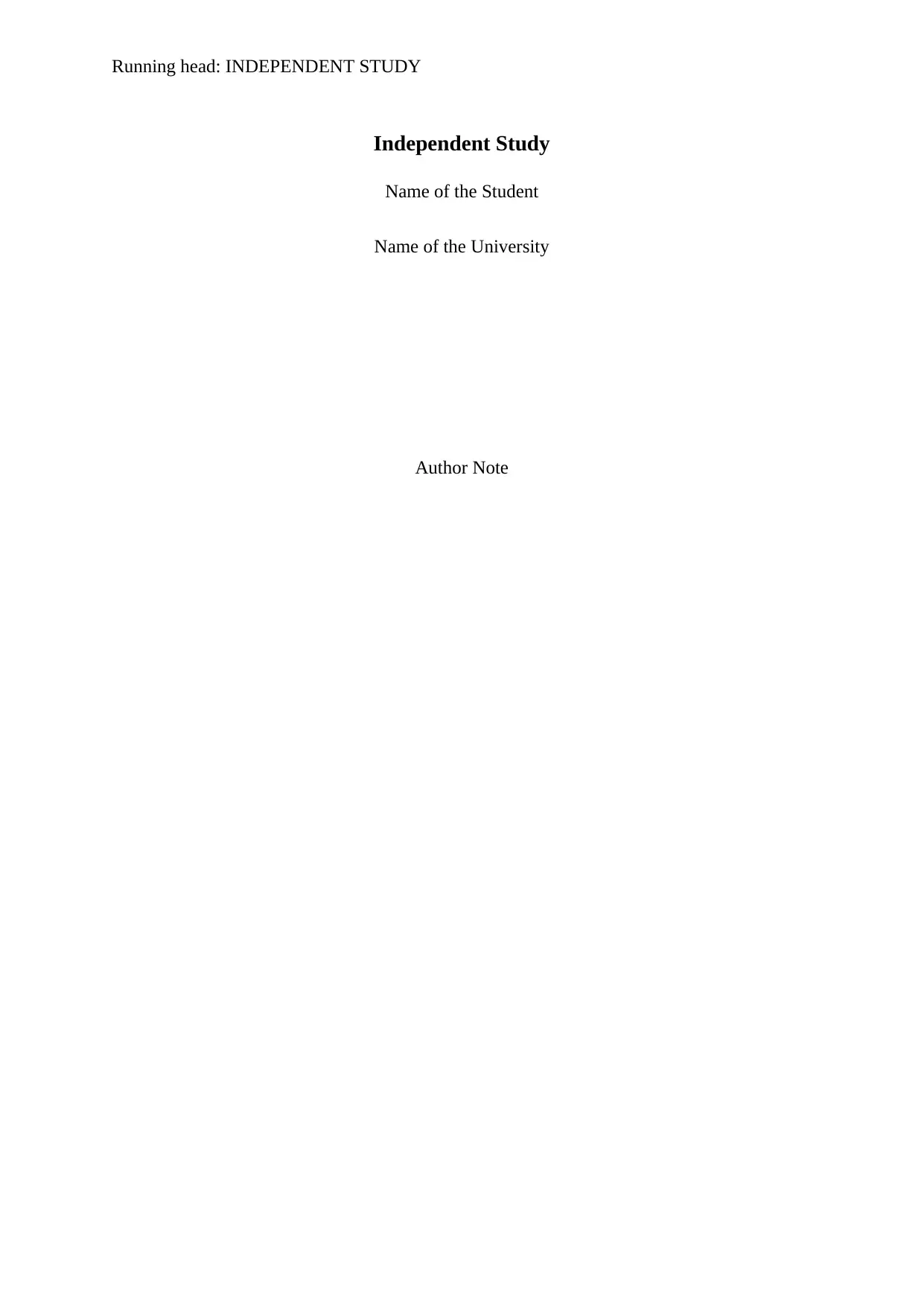
Running head: INDEPENDENT STUDY
Independent Study
Name of the Student
Name of the University
Author Note
Independent Study
Name of the Student
Name of the University
Author Note
Paraphrase This Document
Need a fresh take? Get an instant paraphrase of this document with our AI Paraphraser
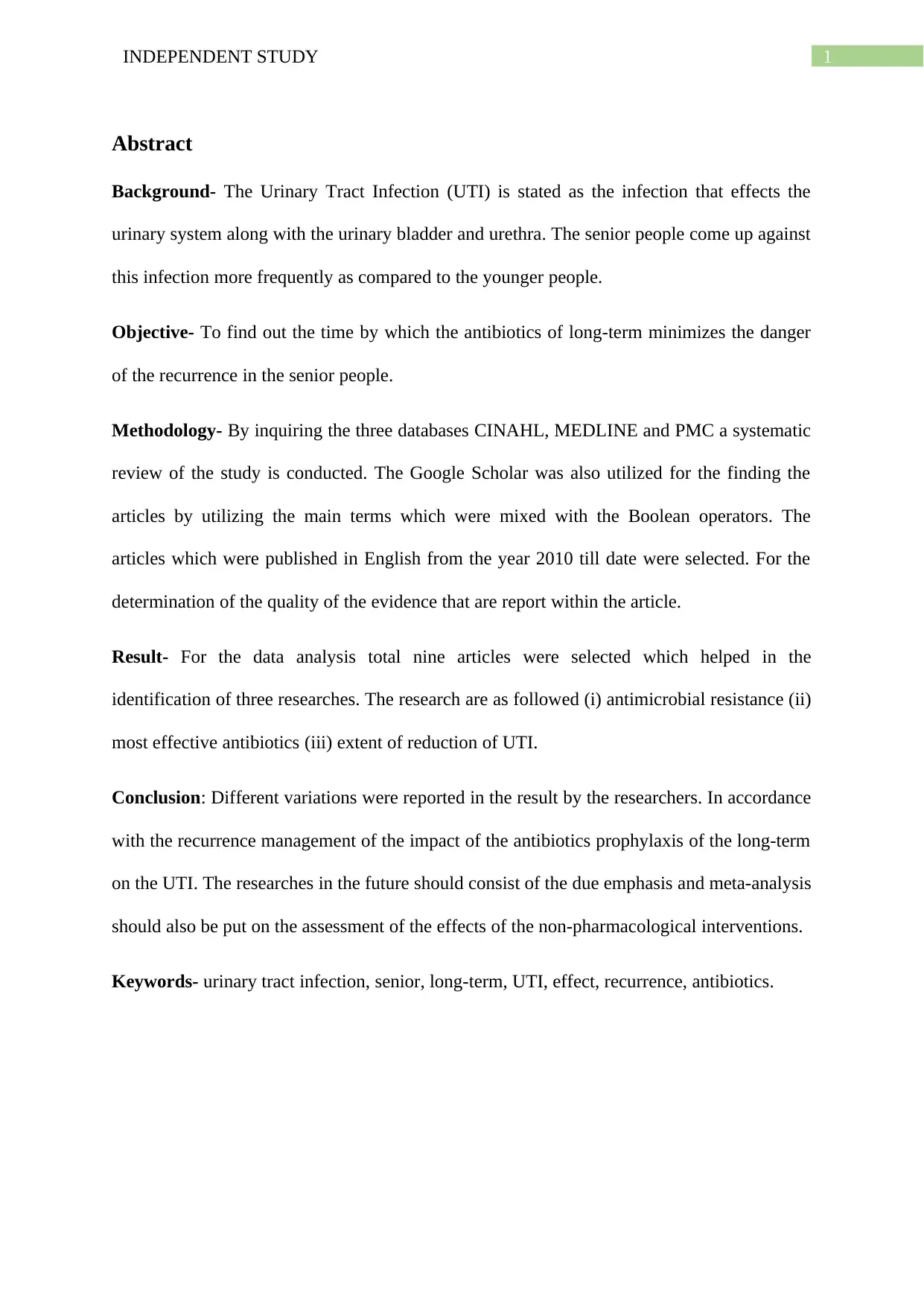
1INDEPENDENT STUDY
Abstract
Background- The Urinary Tract Infection (UTI) is stated as the infection that effects the
urinary system along with the urinary bladder and urethra. The senior people come up against
this infection more frequently as compared to the younger people.
Objective- To find out the time by which the antibiotics of long-term minimizes the danger
of the recurrence in the senior people.
Methodology- By inquiring the three databases CINAHL, MEDLINE and PMC a systematic
review of the study is conducted. The Google Scholar was also utilized for the finding the
articles by utilizing the main terms which were mixed with the Boolean operators. The
articles which were published in English from the year 2010 till date were selected. For the
determination of the quality of the evidence that are report within the article.
Result- For the data analysis total nine articles were selected which helped in the
identification of three researches. The research are as followed (i) antimicrobial resistance (ii)
most effective antibiotics (iii) extent of reduction of UTI.
Conclusion: Different variations were reported in the result by the researchers. In accordance
with the recurrence management of the impact of the antibiotics prophylaxis of the long-term
on the UTI. The researches in the future should consist of the due emphasis and meta-analysis
should also be put on the assessment of the effects of the non-pharmacological interventions.
Keywords- urinary tract infection, senior, long-term, UTI, effect, recurrence, antibiotics.
Abstract
Background- The Urinary Tract Infection (UTI) is stated as the infection that effects the
urinary system along with the urinary bladder and urethra. The senior people come up against
this infection more frequently as compared to the younger people.
Objective- To find out the time by which the antibiotics of long-term minimizes the danger
of the recurrence in the senior people.
Methodology- By inquiring the three databases CINAHL, MEDLINE and PMC a systematic
review of the study is conducted. The Google Scholar was also utilized for the finding the
articles by utilizing the main terms which were mixed with the Boolean operators. The
articles which were published in English from the year 2010 till date were selected. For the
determination of the quality of the evidence that are report within the article.
Result- For the data analysis total nine articles were selected which helped in the
identification of three researches. The research are as followed (i) antimicrobial resistance (ii)
most effective antibiotics (iii) extent of reduction of UTI.
Conclusion: Different variations were reported in the result by the researchers. In accordance
with the recurrence management of the impact of the antibiotics prophylaxis of the long-term
on the UTI. The researches in the future should consist of the due emphasis and meta-analysis
should also be put on the assessment of the effects of the non-pharmacological interventions.
Keywords- urinary tract infection, senior, long-term, UTI, effect, recurrence, antibiotics.
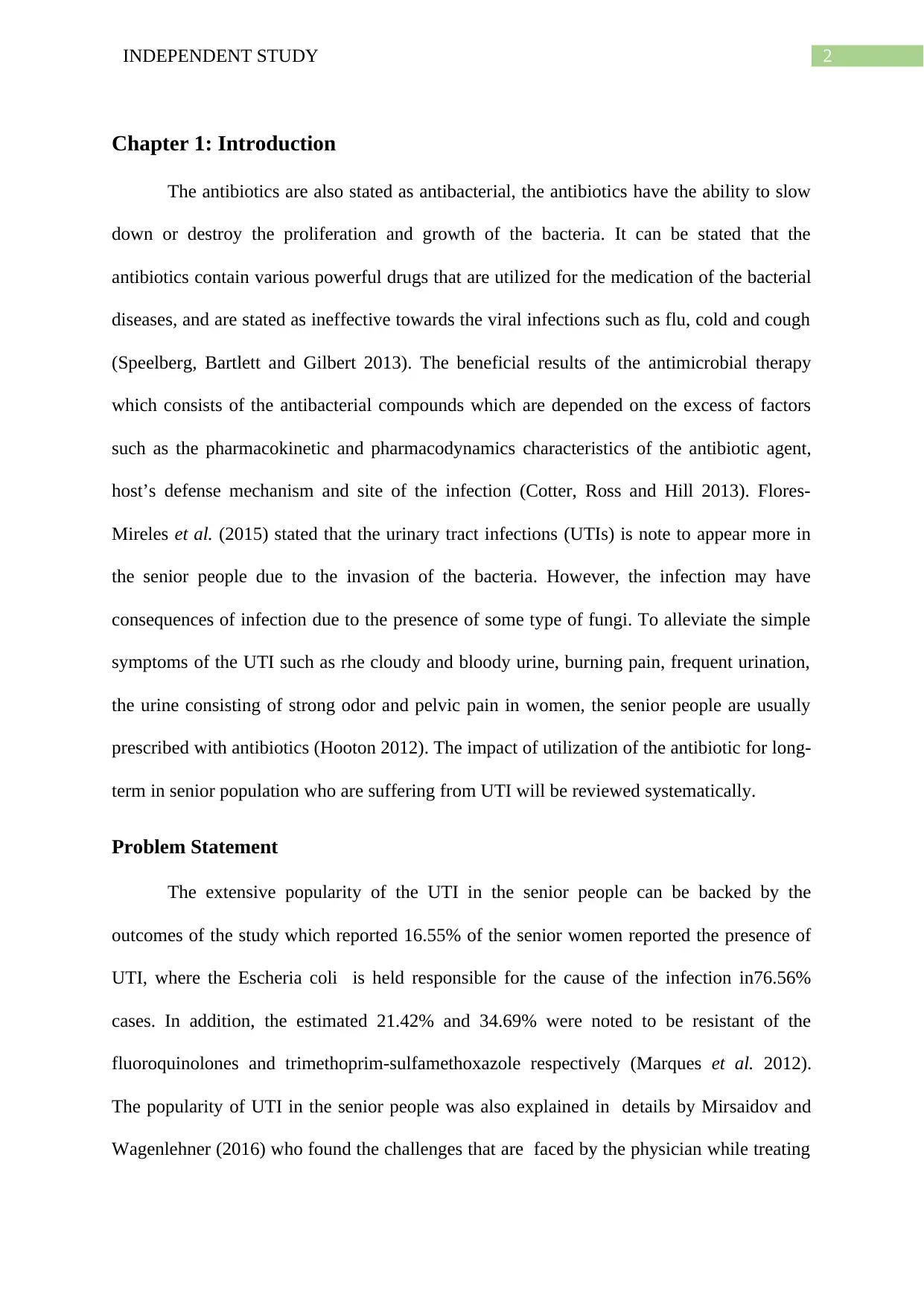
2INDEPENDENT STUDY
Chapter 1: Introduction
The antibiotics are also stated as antibacterial, the antibiotics have the ability to slow
down or destroy the proliferation and growth of the bacteria. It can be stated that the
antibiotics contain various powerful drugs that are utilized for the medication of the bacterial
diseases, and are stated as ineffective towards the viral infections such as flu, cold and cough
(Speelberg, Bartlett and Gilbert 2013). The beneficial results of the antimicrobial therapy
which consists of the antibacterial compounds which are depended on the excess of factors
such as the pharmacokinetic and pharmacodynamics characteristics of the antibiotic agent,
host’s defense mechanism and site of the infection (Cotter, Ross and Hill 2013). Flores-
Mireles et al. (2015) stated that the urinary tract infections (UTIs) is note to appear more in
the senior people due to the invasion of the bacteria. However, the infection may have
consequences of infection due to the presence of some type of fungi. To alleviate the simple
symptoms of the UTI such as rhe cloudy and bloody urine, burning pain, frequent urination,
the urine consisting of strong odor and pelvic pain in women, the senior people are usually
prescribed with antibiotics (Hooton 2012). The impact of utilization of the antibiotic for long-
term in senior population who are suffering from UTI will be reviewed systematically.
Problem Statement
The extensive popularity of the UTI in the senior people can be backed by the
outcomes of the study which reported 16.55% of the senior women reported the presence of
UTI, where the Escheria coli is held responsible for the cause of the infection in76.56%
cases. In addition, the estimated 21.42% and 34.69% were noted to be resistant of the
fluoroquinolones and trimethoprim-sulfamethoxazole respectively (Marques et al. 2012).
The popularity of UTI in the senior people was also explained in details by Mirsaidov and
Wagenlehner (2016) who found the challenges that are faced by the physician while treating
Chapter 1: Introduction
The antibiotics are also stated as antibacterial, the antibiotics have the ability to slow
down or destroy the proliferation and growth of the bacteria. It can be stated that the
antibiotics contain various powerful drugs that are utilized for the medication of the bacterial
diseases, and are stated as ineffective towards the viral infections such as flu, cold and cough
(Speelberg, Bartlett and Gilbert 2013). The beneficial results of the antimicrobial therapy
which consists of the antibacterial compounds which are depended on the excess of factors
such as the pharmacokinetic and pharmacodynamics characteristics of the antibiotic agent,
host’s defense mechanism and site of the infection (Cotter, Ross and Hill 2013). Flores-
Mireles et al. (2015) stated that the urinary tract infections (UTIs) is note to appear more in
the senior people due to the invasion of the bacteria. However, the infection may have
consequences of infection due to the presence of some type of fungi. To alleviate the simple
symptoms of the UTI such as rhe cloudy and bloody urine, burning pain, frequent urination,
the urine consisting of strong odor and pelvic pain in women, the senior people are usually
prescribed with antibiotics (Hooton 2012). The impact of utilization of the antibiotic for long-
term in senior population who are suffering from UTI will be reviewed systematically.
Problem Statement
The extensive popularity of the UTI in the senior people can be backed by the
outcomes of the study which reported 16.55% of the senior women reported the presence of
UTI, where the Escheria coli is held responsible for the cause of the infection in76.56%
cases. In addition, the estimated 21.42% and 34.69% were noted to be resistant of the
fluoroquinolones and trimethoprim-sulfamethoxazole respectively (Marques et al. 2012).
The popularity of UTI in the senior people was also explained in details by Mirsaidov and
Wagenlehner (2016) who found the challenges that are faced by the physician while treating
⊘ This is a preview!⊘
Do you want full access?
Subscribe today to unlock all pages.

Trusted by 1+ million students worldwide
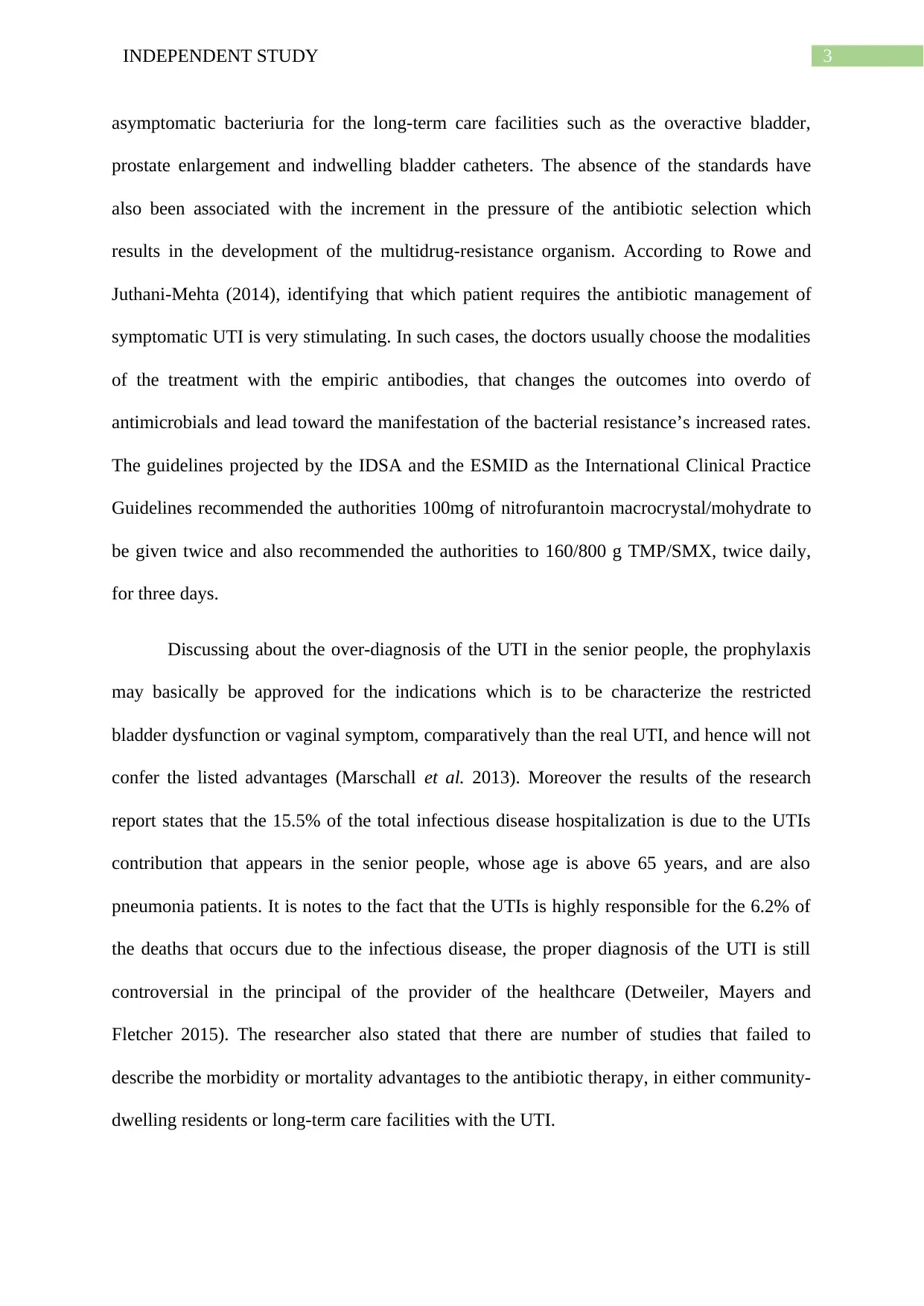
3INDEPENDENT STUDY
asymptomatic bacteriuria for the long-term care facilities such as the overactive bladder,
prostate enlargement and indwelling bladder catheters. The absence of the standards have
also been associated with the increment in the pressure of the antibiotic selection which
results in the development of the multidrug-resistance organism. According to Rowe and
Juthani-Mehta (2014), identifying that which patient requires the antibiotic management of
symptomatic UTI is very stimulating. In such cases, the doctors usually choose the modalities
of the treatment with the empiric antibodies, that changes the outcomes into overdo of
antimicrobials and lead toward the manifestation of the bacterial resistance’s increased rates.
The guidelines projected by the IDSA and the ESMID as the International Clinical Practice
Guidelines recommended the authorities 100mg of nitrofurantoin macrocrystal/mohydrate to
be given twice and also recommended the authorities to 160/800 g TMP/SMX, twice daily,
for three days.
Discussing about the over-diagnosis of the UTI in the senior people, the prophylaxis
may basically be approved for the indications which is to be characterize the restricted
bladder dysfunction or vaginal symptom, comparatively than the real UTI, and hence will not
confer the listed advantages (Marschall et al. 2013). Moreover the results of the research
report states that the 15.5% of the total infectious disease hospitalization is due to the UTIs
contribution that appears in the senior people, whose age is above 65 years, and are also
pneumonia patients. It is notes to the fact that the UTIs is highly responsible for the 6.2% of
the deaths that occurs due to the infectious disease, the proper diagnosis of the UTI is still
controversial in the principal of the provider of the healthcare (Detweiler, Mayers and
Fletcher 2015). The researcher also stated that there are number of studies that failed to
describe the morbidity or mortality advantages to the antibiotic therapy, in either community-
dwelling residents or long-term care facilities with the UTI.
asymptomatic bacteriuria for the long-term care facilities such as the overactive bladder,
prostate enlargement and indwelling bladder catheters. The absence of the standards have
also been associated with the increment in the pressure of the antibiotic selection which
results in the development of the multidrug-resistance organism. According to Rowe and
Juthani-Mehta (2014), identifying that which patient requires the antibiotic management of
symptomatic UTI is very stimulating. In such cases, the doctors usually choose the modalities
of the treatment with the empiric antibodies, that changes the outcomes into overdo of
antimicrobials and lead toward the manifestation of the bacterial resistance’s increased rates.
The guidelines projected by the IDSA and the ESMID as the International Clinical Practice
Guidelines recommended the authorities 100mg of nitrofurantoin macrocrystal/mohydrate to
be given twice and also recommended the authorities to 160/800 g TMP/SMX, twice daily,
for three days.
Discussing about the over-diagnosis of the UTI in the senior people, the prophylaxis
may basically be approved for the indications which is to be characterize the restricted
bladder dysfunction or vaginal symptom, comparatively than the real UTI, and hence will not
confer the listed advantages (Marschall et al. 2013). Moreover the results of the research
report states that the 15.5% of the total infectious disease hospitalization is due to the UTIs
contribution that appears in the senior people, whose age is above 65 years, and are also
pneumonia patients. It is notes to the fact that the UTIs is highly responsible for the 6.2% of
the deaths that occurs due to the infectious disease, the proper diagnosis of the UTI is still
controversial in the principal of the provider of the healthcare (Detweiler, Mayers and
Fletcher 2015). The researcher also stated that there are number of studies that failed to
describe the morbidity or mortality advantages to the antibiotic therapy, in either community-
dwelling residents or long-term care facilities with the UTI.
Paraphrase This Document
Need a fresh take? Get an instant paraphrase of this document with our AI Paraphraser
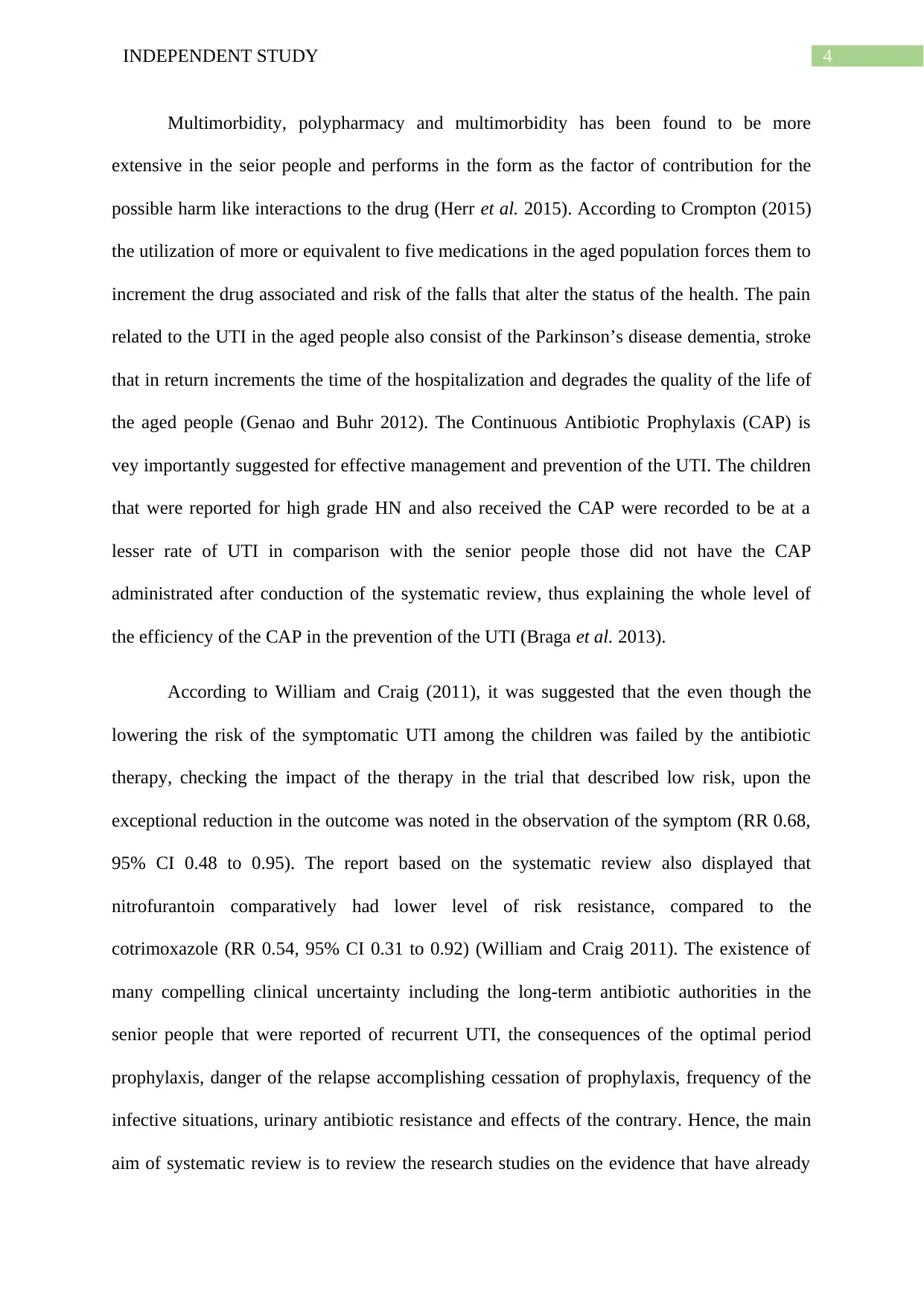
4INDEPENDENT STUDY
Multimorbidity, polypharmacy and multimorbidity has been found to be more
extensive in the seior people and performs in the form as the factor of contribution for the
possible harm like interactions to the drug (Herr et al. 2015). According to Crompton (2015)
the utilization of more or equivalent to five medications in the aged population forces them to
increment the drug associated and risk of the falls that alter the status of the health. The pain
related to the UTI in the aged people also consist of the Parkinson’s disease dementia, stroke
that in return increments the time of the hospitalization and degrades the quality of the life of
the aged people (Genao and Buhr 2012). The Continuous Antibiotic Prophylaxis (CAP) is
vey importantly suggested for effective management and prevention of the UTI. The children
that were reported for high grade HN and also received the CAP were recorded to be at a
lesser rate of UTI in comparison with the senior people those did not have the CAP
administrated after conduction of the systematic review, thus explaining the whole level of
the efficiency of the CAP in the prevention of the UTI (Braga et al. 2013).
According to William and Craig (2011), it was suggested that the even though the
lowering the risk of the symptomatic UTI among the children was failed by the antibiotic
therapy, checking the impact of the therapy in the trial that described low risk, upon the
exceptional reduction in the outcome was noted in the observation of the symptom (RR 0.68,
95% CI 0.48 to 0.95). The report based on the systematic review also displayed that
nitrofurantoin comparatively had lower level of risk resistance, compared to the
cotrimoxazole (RR 0.54, 95% CI 0.31 to 0.92) (William and Craig 2011). The existence of
many compelling clinical uncertainty including the long-term antibiotic authorities in the
senior people that were reported of recurrent UTI, the consequences of the optimal period
prophylaxis, danger of the relapse accomplishing cessation of prophylaxis, frequency of the
infective situations, urinary antibiotic resistance and effects of the contrary. Hence, the main
aim of systematic review is to review the research studies on the evidence that have already
Multimorbidity, polypharmacy and multimorbidity has been found to be more
extensive in the seior people and performs in the form as the factor of contribution for the
possible harm like interactions to the drug (Herr et al. 2015). According to Crompton (2015)
the utilization of more or equivalent to five medications in the aged population forces them to
increment the drug associated and risk of the falls that alter the status of the health. The pain
related to the UTI in the aged people also consist of the Parkinson’s disease dementia, stroke
that in return increments the time of the hospitalization and degrades the quality of the life of
the aged people (Genao and Buhr 2012). The Continuous Antibiotic Prophylaxis (CAP) is
vey importantly suggested for effective management and prevention of the UTI. The children
that were reported for high grade HN and also received the CAP were recorded to be at a
lesser rate of UTI in comparison with the senior people those did not have the CAP
administrated after conduction of the systematic review, thus explaining the whole level of
the efficiency of the CAP in the prevention of the UTI (Braga et al. 2013).
According to William and Craig (2011), it was suggested that the even though the
lowering the risk of the symptomatic UTI among the children was failed by the antibiotic
therapy, checking the impact of the therapy in the trial that described low risk, upon the
exceptional reduction in the outcome was noted in the observation of the symptom (RR 0.68,
95% CI 0.48 to 0.95). The report based on the systematic review also displayed that
nitrofurantoin comparatively had lower level of risk resistance, compared to the
cotrimoxazole (RR 0.54, 95% CI 0.31 to 0.92) (William and Craig 2011). The existence of
many compelling clinical uncertainty including the long-term antibiotic authorities in the
senior people that were reported of recurrent UTI, the consequences of the optimal period
prophylaxis, danger of the relapse accomplishing cessation of prophylaxis, frequency of the
infective situations, urinary antibiotic resistance and effects of the contrary. Hence, the main
aim of systematic review is to review the research studies on the evidence that have already
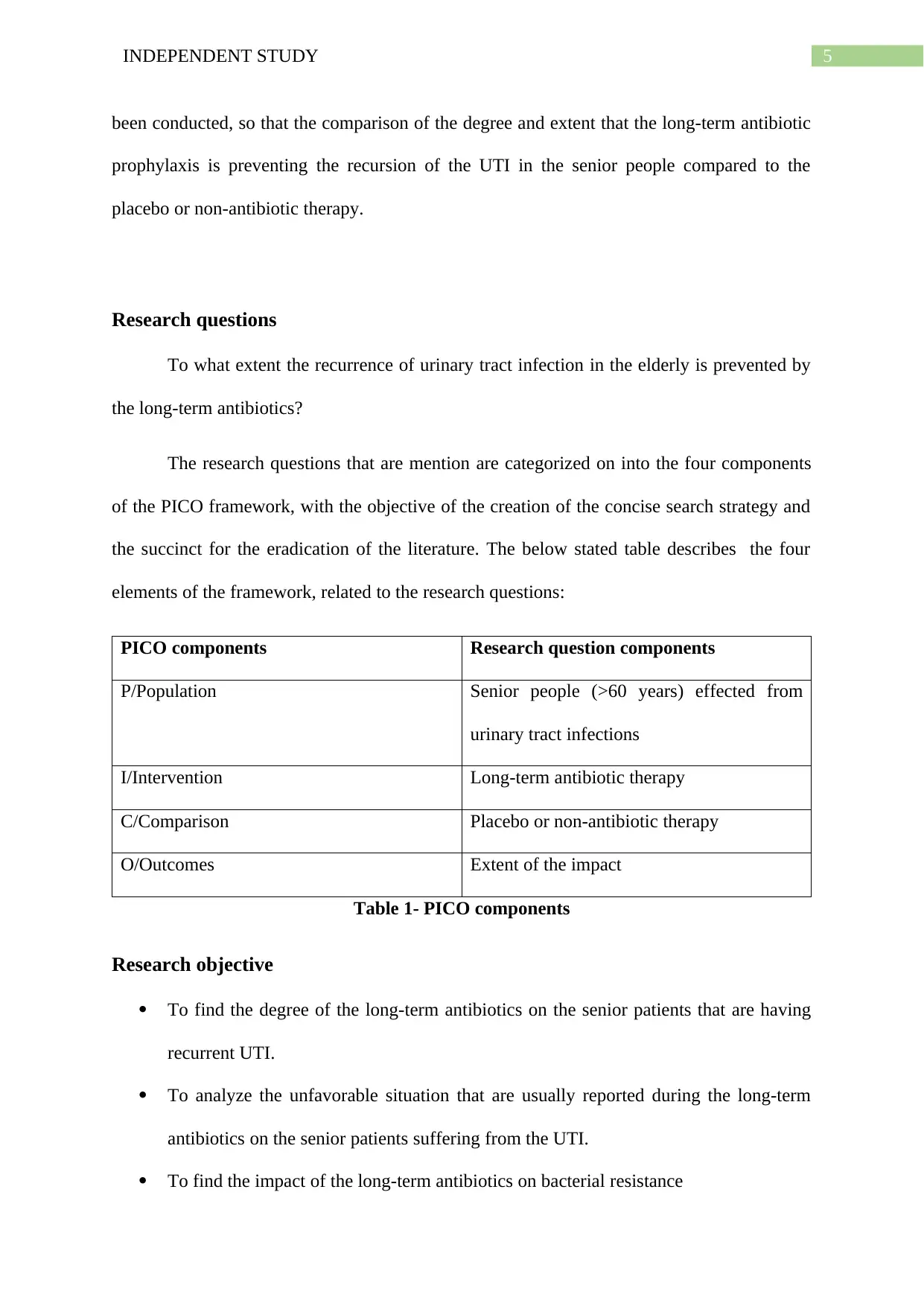
5INDEPENDENT STUDY
been conducted, so that the comparison of the degree and extent that the long-term antibiotic
prophylaxis is preventing the recursion of the UTI in the senior people compared to the
placebo or non-antibiotic therapy.
Research questions
To what extent the recurrence of urinary tract infection in the elderly is prevented by
the long-term antibiotics?
The research questions that are mention are categorized on into the four components
of the PICO framework, with the objective of the creation of the concise search strategy and
the succinct for the eradication of the literature. The below stated table describes the four
elements of the framework, related to the research questions:
PICO components Research question components
P/Population Senior people (>60 years) effected from
urinary tract infections
I/Intervention Long-term antibiotic therapy
C/Comparison Placebo or non-antibiotic therapy
O/Outcomes Extent of the impact
Table 1- PICO components
Research objective
To find the degree of the long-term antibiotics on the senior patients that are having
recurrent UTI.
To analyze the unfavorable situation that are usually reported during the long-term
antibiotics on the senior patients suffering from the UTI.
To find the impact of the long-term antibiotics on bacterial resistance
been conducted, so that the comparison of the degree and extent that the long-term antibiotic
prophylaxis is preventing the recursion of the UTI in the senior people compared to the
placebo or non-antibiotic therapy.
Research questions
To what extent the recurrence of urinary tract infection in the elderly is prevented by
the long-term antibiotics?
The research questions that are mention are categorized on into the four components
of the PICO framework, with the objective of the creation of the concise search strategy and
the succinct for the eradication of the literature. The below stated table describes the four
elements of the framework, related to the research questions:
PICO components Research question components
P/Population Senior people (>60 years) effected from
urinary tract infections
I/Intervention Long-term antibiotic therapy
C/Comparison Placebo or non-antibiotic therapy
O/Outcomes Extent of the impact
Table 1- PICO components
Research objective
To find the degree of the long-term antibiotics on the senior patients that are having
recurrent UTI.
To analyze the unfavorable situation that are usually reported during the long-term
antibiotics on the senior patients suffering from the UTI.
To find the impact of the long-term antibiotics on bacterial resistance
⊘ This is a preview!⊘
Do you want full access?
Subscribe today to unlock all pages.

Trusted by 1+ million students worldwide
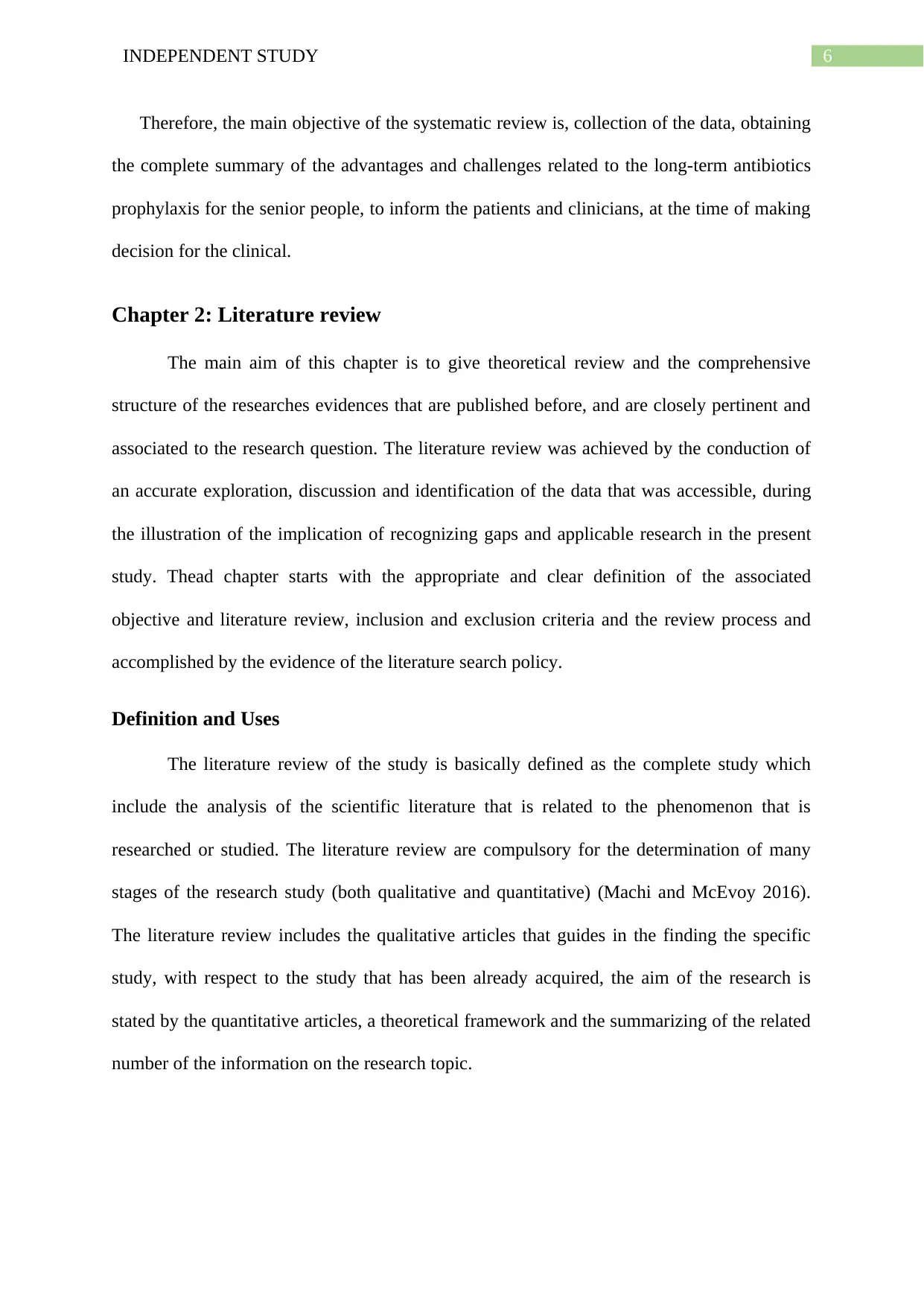
6INDEPENDENT STUDY
Therefore, the main objective of the systematic review is, collection of the data, obtaining
the complete summary of the advantages and challenges related to the long-term antibiotics
prophylaxis for the senior people, to inform the patients and clinicians, at the time of making
decision for the clinical.
Chapter 2: Literature review
The main aim of this chapter is to give theoretical review and the comprehensive
structure of the researches evidences that are published before, and are closely pertinent and
associated to the research question. The literature review was achieved by the conduction of
an accurate exploration, discussion and identification of the data that was accessible, during
the illustration of the implication of recognizing gaps and applicable research in the present
study. Thead chapter starts with the appropriate and clear definition of the associated
objective and literature review, inclusion and exclusion criteria and the review process and
accomplished by the evidence of the literature search policy.
Definition and Uses
The literature review of the study is basically defined as the complete study which
include the analysis of the scientific literature that is related to the phenomenon that is
researched or studied. The literature review are compulsory for the determination of many
stages of the research study (both qualitative and quantitative) (Machi and McEvoy 2016).
The literature review includes the qualitative articles that guides in the finding the specific
study, with respect to the study that has been already acquired, the aim of the research is
stated by the quantitative articles, a theoretical framework and the summarizing of the related
number of the information on the research topic.
Therefore, the main objective of the systematic review is, collection of the data, obtaining
the complete summary of the advantages and challenges related to the long-term antibiotics
prophylaxis for the senior people, to inform the patients and clinicians, at the time of making
decision for the clinical.
Chapter 2: Literature review
The main aim of this chapter is to give theoretical review and the comprehensive
structure of the researches evidences that are published before, and are closely pertinent and
associated to the research question. The literature review was achieved by the conduction of
an accurate exploration, discussion and identification of the data that was accessible, during
the illustration of the implication of recognizing gaps and applicable research in the present
study. Thead chapter starts with the appropriate and clear definition of the associated
objective and literature review, inclusion and exclusion criteria and the review process and
accomplished by the evidence of the literature search policy.
Definition and Uses
The literature review of the study is basically defined as the complete study which
include the analysis of the scientific literature that is related to the phenomenon that is
researched or studied. The literature review are compulsory for the determination of many
stages of the research study (both qualitative and quantitative) (Machi and McEvoy 2016).
The literature review includes the qualitative articles that guides in the finding the specific
study, with respect to the study that has been already acquired, the aim of the research is
stated by the quantitative articles, a theoretical framework and the summarizing of the related
number of the information on the research topic.
Paraphrase This Document
Need a fresh take? Get an instant paraphrase of this document with our AI Paraphraser
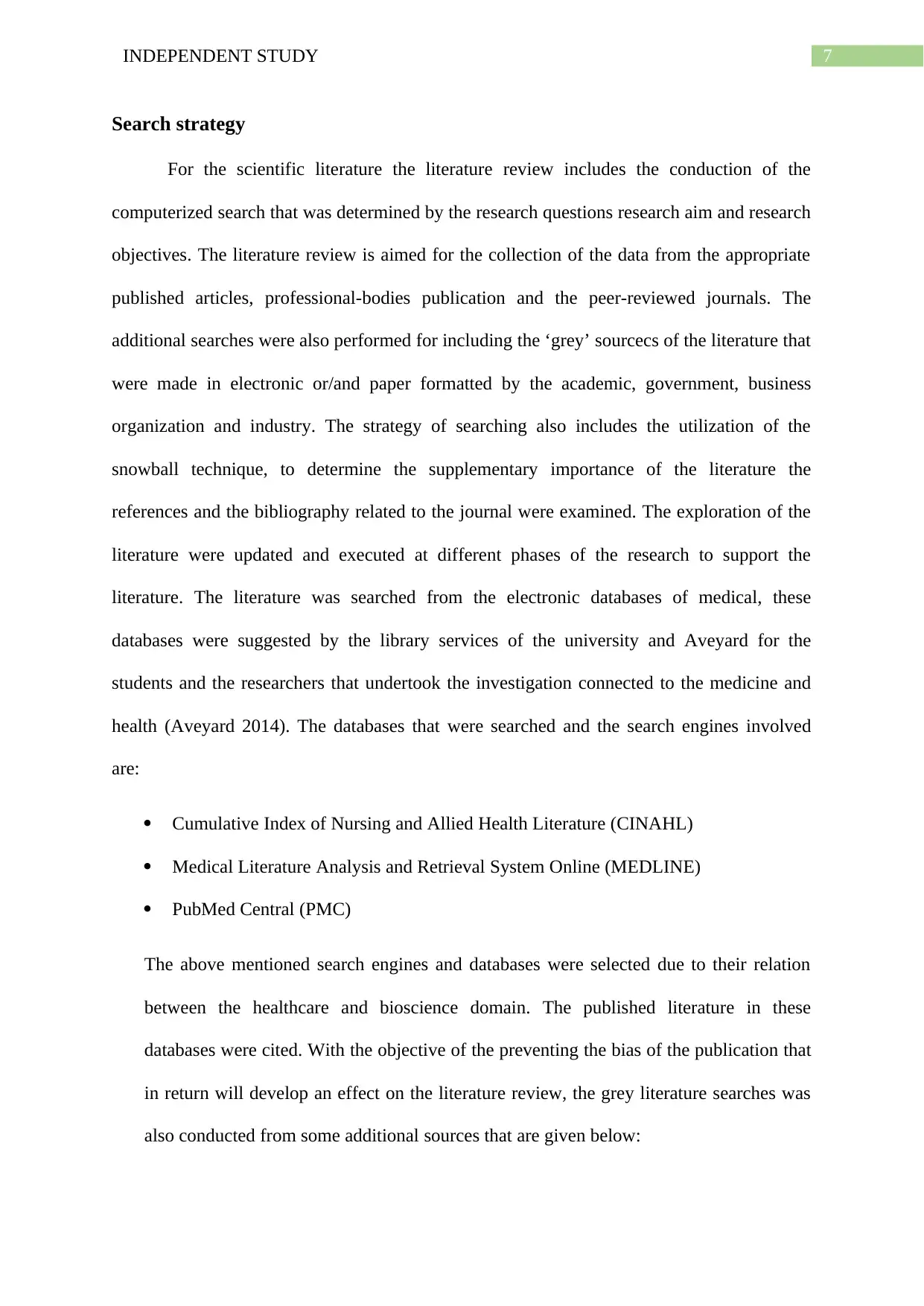
7INDEPENDENT STUDY
Search strategy
For the scientific literature the literature review includes the conduction of the
computerized search that was determined by the research questions research aim and research
objectives. The literature review is aimed for the collection of the data from the appropriate
published articles, professional-bodies publication and the peer-reviewed journals. The
additional searches were also performed for including the ‘grey’ sourcecs of the literature that
were made in electronic or/and paper formatted by the academic, government, business
organization and industry. The strategy of searching also includes the utilization of the
snowball technique, to determine the supplementary importance of the literature the
references and the bibliography related to the journal were examined. The exploration of the
literature were updated and executed at different phases of the research to support the
literature. The literature was searched from the electronic databases of medical, these
databases were suggested by the library services of the university and Aveyard for the
students and the researchers that undertook the investigation connected to the medicine and
health (Aveyard 2014). The databases that were searched and the search engines involved
are:
Cumulative Index of Nursing and Allied Health Literature (CINAHL)
Medical Literature Analysis and Retrieval System Online (MEDLINE)
PubMed Central (PMC)
The above mentioned search engines and databases were selected due to their relation
between the healthcare and bioscience domain. The published literature in these
databases were cited. With the objective of the preventing the bias of the publication that
in return will develop an effect on the literature review, the grey literature searches was
also conducted from some additional sources that are given below:
Search strategy
For the scientific literature the literature review includes the conduction of the
computerized search that was determined by the research questions research aim and research
objectives. The literature review is aimed for the collection of the data from the appropriate
published articles, professional-bodies publication and the peer-reviewed journals. The
additional searches were also performed for including the ‘grey’ sourcecs of the literature that
were made in electronic or/and paper formatted by the academic, government, business
organization and industry. The strategy of searching also includes the utilization of the
snowball technique, to determine the supplementary importance of the literature the
references and the bibliography related to the journal were examined. The exploration of the
literature were updated and executed at different phases of the research to support the
literature. The literature was searched from the electronic databases of medical, these
databases were suggested by the library services of the university and Aveyard for the
students and the researchers that undertook the investigation connected to the medicine and
health (Aveyard 2014). The databases that were searched and the search engines involved
are:
Cumulative Index of Nursing and Allied Health Literature (CINAHL)
Medical Literature Analysis and Retrieval System Online (MEDLINE)
PubMed Central (PMC)
The above mentioned search engines and databases were selected due to their relation
between the healthcare and bioscience domain. The published literature in these
databases were cited. With the objective of the preventing the bias of the publication that
in return will develop an effect on the literature review, the grey literature searches was
also conducted from some additional sources that are given below:
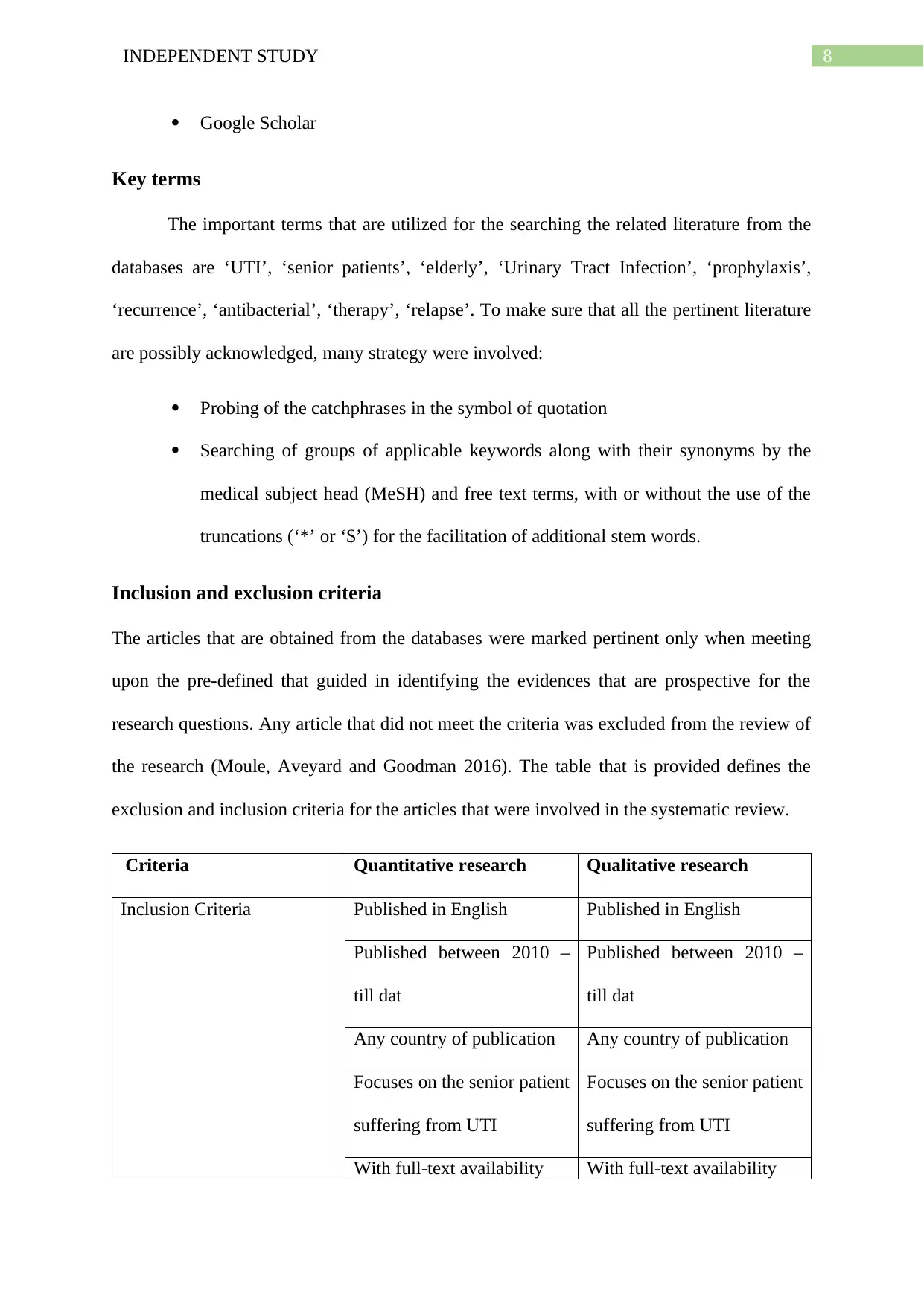
8INDEPENDENT STUDY
Google Scholar
Key terms
The important terms that are utilized for the searching the related literature from the
databases are ‘UTI’, ‘senior patients’, ‘elderly’, ‘Urinary Tract Infection’, ‘prophylaxis’,
‘recurrence’, ‘antibacterial’, ‘therapy’, ‘relapse’. To make sure that all the pertinent literature
are possibly acknowledged, many strategy were involved:
Probing of the catchphrases in the symbol of quotation
Searching of groups of applicable keywords along with their synonyms by the
medical subject head (MeSH) and free text terms, with or without the use of the
truncations (‘*’ or ‘$’) for the facilitation of additional stem words.
Inclusion and exclusion criteria
The articles that are obtained from the databases were marked pertinent only when meeting
upon the pre-defined that guided in identifying the evidences that are prospective for the
research questions. Any article that did not meet the criteria was excluded from the review of
the research (Moule, Aveyard and Goodman 2016). The table that is provided defines the
exclusion and inclusion criteria for the articles that were involved in the systematic review.
Criteria Quantitative research Qualitative research
Inclusion Criteria Published in English Published in English
Published between 2010 –
till dat
Published between 2010 –
till dat
Any country of publication Any country of publication
Focuses on the senior patient
suffering from UTI
Focuses on the senior patient
suffering from UTI
With full-text availability With full-text availability
Google Scholar
Key terms
The important terms that are utilized for the searching the related literature from the
databases are ‘UTI’, ‘senior patients’, ‘elderly’, ‘Urinary Tract Infection’, ‘prophylaxis’,
‘recurrence’, ‘antibacterial’, ‘therapy’, ‘relapse’. To make sure that all the pertinent literature
are possibly acknowledged, many strategy were involved:
Probing of the catchphrases in the symbol of quotation
Searching of groups of applicable keywords along with their synonyms by the
medical subject head (MeSH) and free text terms, with or without the use of the
truncations (‘*’ or ‘$’) for the facilitation of additional stem words.
Inclusion and exclusion criteria
The articles that are obtained from the databases were marked pertinent only when meeting
upon the pre-defined that guided in identifying the evidences that are prospective for the
research questions. Any article that did not meet the criteria was excluded from the review of
the research (Moule, Aveyard and Goodman 2016). The table that is provided defines the
exclusion and inclusion criteria for the articles that were involved in the systematic review.
Criteria Quantitative research Qualitative research
Inclusion Criteria Published in English Published in English
Published between 2010 –
till dat
Published between 2010 –
till dat
Any country of publication Any country of publication
Focuses on the senior patient
suffering from UTI
Focuses on the senior patient
suffering from UTI
With full-text availability With full-text availability
⊘ This is a preview!⊘
Do you want full access?
Subscribe today to unlock all pages.

Trusted by 1+ million students worldwide
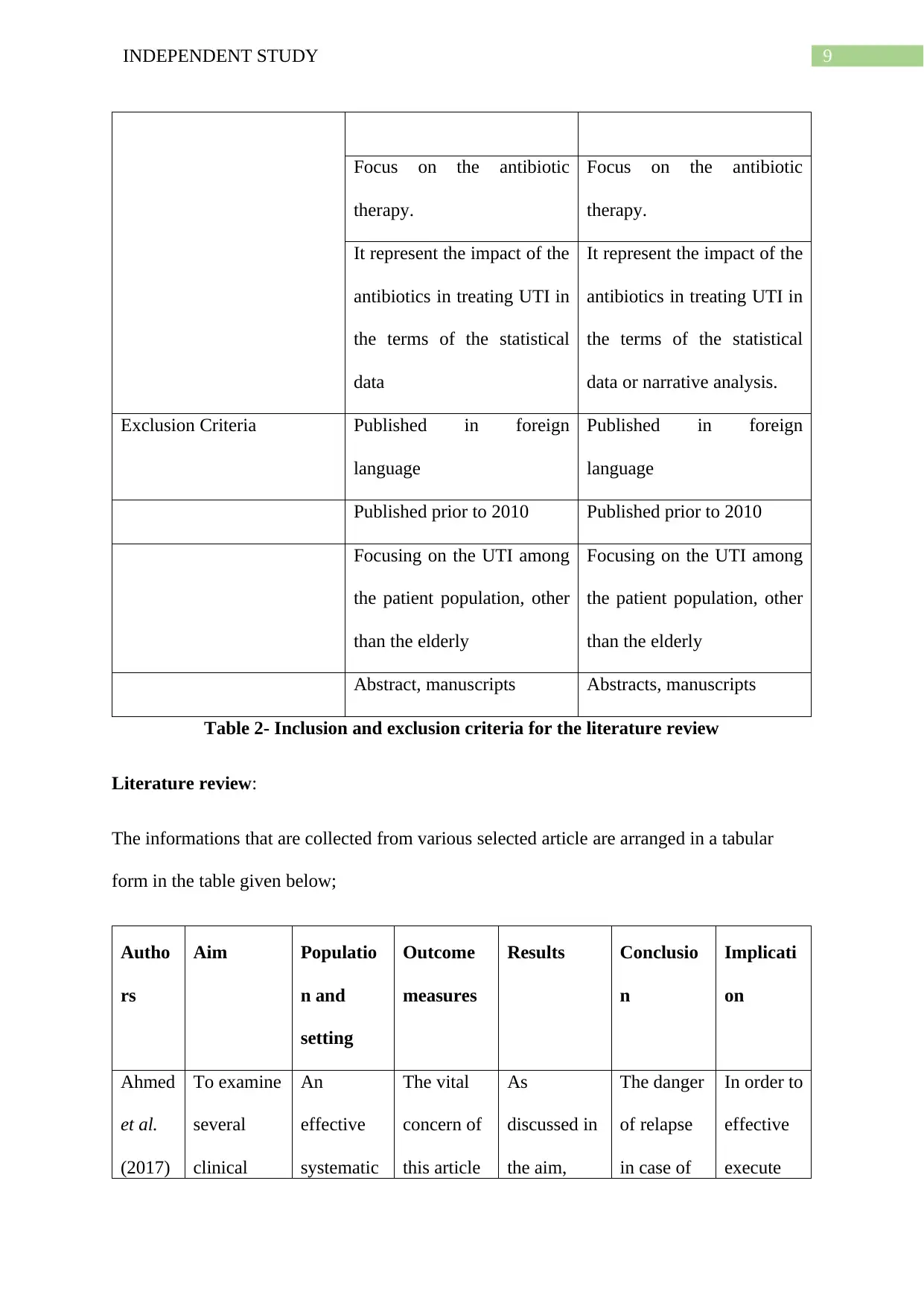
9INDEPENDENT STUDY
Focus on the antibiotic
therapy.
Focus on the antibiotic
therapy.
It represent the impact of the
antibiotics in treating UTI in
the terms of the statistical
data
It represent the impact of the
antibiotics in treating UTI in
the terms of the statistical
data or narrative analysis.
Exclusion Criteria Published in foreign
language
Published in foreign
language
Published prior to 2010 Published prior to 2010
Focusing on the UTI among
the patient population, other
than the elderly
Focusing on the UTI among
the patient population, other
than the elderly
Abstract, manuscripts Abstracts, manuscripts
Table 2- Inclusion and exclusion criteria for the literature review
Literature review:
The informations that are collected from various selected article are arranged in a tabular
form in the table given below;
Autho
rs
Aim Populatio
n and
setting
Outcome
measures
Results Conclusio
n
Implicati
on
Ahmed
et al.
(2017)
To examine
several
clinical
An
effective
systematic
The vital
concern of
this article
As
discussed in
the aim,
The danger
of relapse
in case of
In order to
effective
execute
Focus on the antibiotic
therapy.
Focus on the antibiotic
therapy.
It represent the impact of the
antibiotics in treating UTI in
the terms of the statistical
data
It represent the impact of the
antibiotics in treating UTI in
the terms of the statistical
data or narrative analysis.
Exclusion Criteria Published in foreign
language
Published in foreign
language
Published prior to 2010 Published prior to 2010
Focusing on the UTI among
the patient population, other
than the elderly
Focusing on the UTI among
the patient population, other
than the elderly
Abstract, manuscripts Abstracts, manuscripts
Table 2- Inclusion and exclusion criteria for the literature review
Literature review:
The informations that are collected from various selected article are arranged in a tabular
form in the table given below;
Autho
rs
Aim Populatio
n and
setting
Outcome
measures
Results Conclusio
n
Implicati
on
Ahmed
et al.
(2017)
To examine
several
clinical
An
effective
systematic
The vital
concern of
this article
As
discussed in
the aim,
The danger
of relapse
in case of
In order to
effective
execute
Paraphrase This Document
Need a fresh take? Get an instant paraphrase of this document with our AI Paraphraser
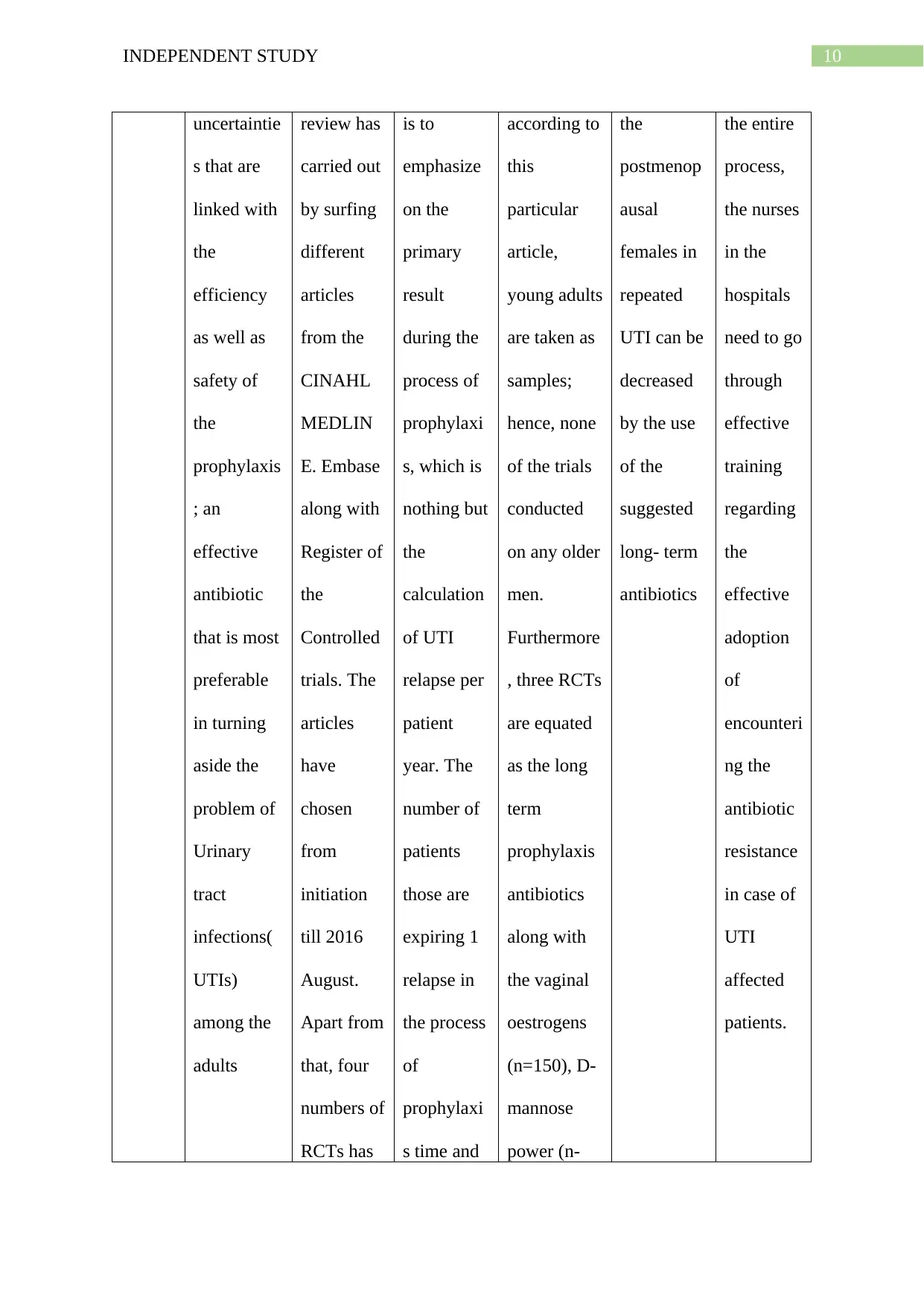
10INDEPENDENT STUDY
uncertaintie
s that are
linked with
the
efficiency
as well as
safety of
the
prophylaxis
; an
effective
antibiotic
that is most
preferable
in turning
aside the
problem of
Urinary
tract
infections(
UTIs)
among the
adults
review has
carried out
by surfing
different
articles
from the
CINAHL
MEDLIN
E. Embase
along with
Register of
the
Controlled
trials. The
articles
have
chosen
from
initiation
till 2016
August.
Apart from
that, four
numbers of
RCTs has
is to
emphasize
on the
primary
result
during the
process of
prophylaxi
s, which is
nothing but
the
calculation
of UTI
relapse per
patient
year. The
number of
patients
those are
expiring 1
relapse in
the process
of
prophylaxi
s time and
according to
this
particular
article,
young adults
are taken as
samples;
hence, none
of the trials
conducted
on any older
men.
Furthermore
, three RCTs
are equated
as the long
term
prophylaxis
antibiotics
along with
the vaginal
oestrogens
(n=150), D-
mannose
power (n-
the
postmenop
ausal
females in
repeated
UTI can be
decreased
by the use
of the
suggested
long- term
antibiotics
the entire
process,
the nurses
in the
hospitals
need to go
through
effective
training
regarding
the
effective
adoption
of
encounteri
ng the
antibiotic
resistance
in case of
UTI
affected
patients.
uncertaintie
s that are
linked with
the
efficiency
as well as
safety of
the
prophylaxis
; an
effective
antibiotic
that is most
preferable
in turning
aside the
problem of
Urinary
tract
infections(
UTIs)
among the
adults
review has
carried out
by surfing
different
articles
from the
CINAHL
MEDLIN
E. Embase
along with
Register of
the
Controlled
trials. The
articles
have
chosen
from
initiation
till 2016
August.
Apart from
that, four
numbers of
RCTs has
is to
emphasize
on the
primary
result
during the
process of
prophylaxi
s, which is
nothing but
the
calculation
of UTI
relapse per
patient
year. The
number of
patients
those are
expiring 1
relapse in
the process
of
prophylaxi
s time and
according to
this
particular
article,
young adults
are taken as
samples;
hence, none
of the trials
conducted
on any older
men.
Furthermore
, three RCTs
are equated
as the long
term
prophylaxis
antibiotics
along with
the vaginal
oestrogens
(n=150), D-
mannose
power (n-
the
postmenop
ausal
females in
repeated
UTI can be
decreased
by the use
of the
suggested
long- term
antibiotics
the entire
process,
the nurses
in the
hospitals
need to go
through
effective
training
regarding
the
effective
adoption
of
encounteri
ng the
antibiotic
resistance
in case of
UTI
affected
patients.
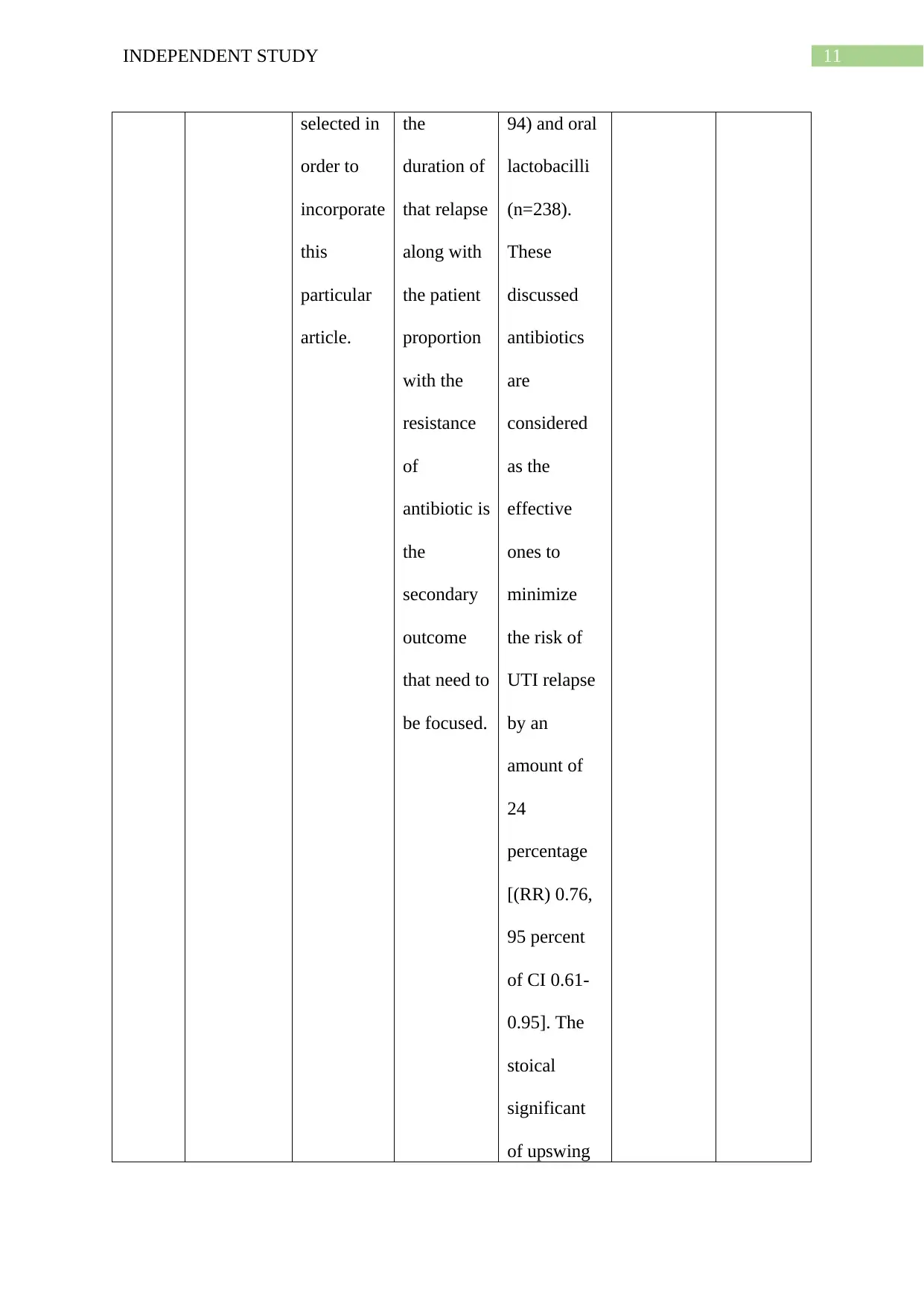
11INDEPENDENT STUDY
selected in
order to
incorporate
this
particular
article.
the
duration of
that relapse
along with
the patient
proportion
with the
resistance
of
antibiotic is
the
secondary
outcome
that need to
be focused.
94) and oral
lactobacilli
(n=238).
These
discussed
antibiotics
are
considered
as the
effective
ones to
minimize
the risk of
UTI relapse
by an
amount of
24
percentage
[(RR) 0.76,
95 percent
of CI 0.61-
0.95]. The
stoical
significant
of upswing
selected in
order to
incorporate
this
particular
article.
the
duration of
that relapse
along with
the patient
proportion
with the
resistance
of
antibiotic is
the
secondary
outcome
that need to
be focused.
94) and oral
lactobacilli
(n=238).
These
discussed
antibiotics
are
considered
as the
effective
ones to
minimize
the risk of
UTI relapse
by an
amount of
24
percentage
[(RR) 0.76,
95 percent
of CI 0.61-
0.95]. The
stoical
significant
of upswing
⊘ This is a preview!⊘
Do you want full access?
Subscribe today to unlock all pages.

Trusted by 1+ million students worldwide
1 out of 50
Related Documents
Your All-in-One AI-Powered Toolkit for Academic Success.
+13062052269
info@desklib.com
Available 24*7 on WhatsApp / Email
![[object Object]](/_next/static/media/star-bottom.7253800d.svg)
Unlock your academic potential
Copyright © 2020–2025 A2Z Services. All Rights Reserved. Developed and managed by ZUCOL.





